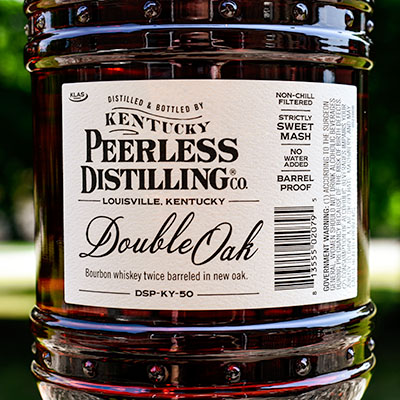• Peerless Distillery uses a sweet mash.
• A combination Vendome column still-pot still doubler with a distillation proof of 131.
• All their whiskey is non-chill filtered.
• Their Kelvin Cooperage new American oak barrels get a medium toast before they are charred to a level #3. Their barrel entry proof is 107.
• Peerless Double Oak Batch 13 is 5 years and 9 months old. As for the double oak finishing, some are aged for a few months, while others may have aged upwards of a year or more in the second barrel.
• Peerless is very tight-lipped about their mash bill, but they told me that they do not use a high-rye mash bill for their Small Batch Double Oak Bourbon.
What started as a way of salvaging whiskey from an irreparable leaky barrel to a new charred oak barrel evolved into a deliberate practice for Peerless Double Oak bourbon, becoming a regular release towards the end of 2021. Let’s get started!
 Taken: Neat in a Glencairn glass, rested for about 15 minutes.
Taken: Neat in a Glencairn glass, rested for about 15 minutes.
Distillery: Kentucky Peerless Distilling Co.
Batch#: 13.
Proof: 108.5, barrel proof, non-chill filtered.
Age: NAS, told by Peerless this batch is 5 years, 9 months old.
Mash bill: Undisclosed.
Price: $99.00.
Appearance: Dark caramel.
Nose
Right from the get-go, I can tell this is complex. First up is caramelized dark brown sugar, root beer, toffee, chocolate, molasses, and vanilla. To balance out all the delicious, rich, and sweet oak flavors, there are upfront herbaceous notes of fennel, cloves, spearmint, and green pepper. More time and swirling bring out the fruitier flavors of dates, nectarines, and some lemon brightness. Underneath, there is a layer of cinnamon spice and toasted hazelnuts. With more sips, the caramel flavors become sweeter, with more root beer, added Whopper malt balls, and a bit of orange. This nose is fantastic.
Palate
Following the nose, the palate leads with caramelized dark brown sugar, root beer, toffee, chocolate, malt, and molasses. Mid-sip, there’s vanilla beans with fennel, mint, and cloves. There’s less stone fruit on the palate but with everything else that’s going on here, I’m okay with that. A very good balance of cinnamon spice and a creamy mouthfeel covers the palate with toasted oak. This is a super delicious pour that drinks below its proof and makes you look forward to your next sip.
Finish
Cinnamon spice lingers with brown sugar, chocolate, molasses, cloves, and mint, along with some stone fruit and toasted oak. As the finish continues, root beer, malt, toasted oak, leather, and pipe tobacco create a long and tasty oak-forward finish.
Conclusion
I’ve read several positive reviews for this release and can now see why. This bottle took more than a few pours to show its full potential, but it kept me busy finding new things to love about it—especially that root beer note! I wasn’t expecting all the upfront herbaceous flavors either, which do a great job of balancing the oak while adding complexity. But not everyone is into double-oaked whiskeys. Some find them too sweet or boring. Although Peerless Double Oak Bourbon reminds me a bit of Woodford Reserve Double Oak with its brown sugar and chocolate flavors, this batch is on another level in terms of complexity and far from being that sweet.
The biggest complaint I hear about Peerless Double Oak is the price. I didn’t like paying over $100 with tax, either. I can see why paying so much for this bottle could be a deterrent when there are many other, less expensive choices. Then again, there are more expensive ones, too. But if you’re a fan of double oak bourbons and decide to take the plunge, I don’t think you’ll be disappointed with this purchase. I wasn’t.
My only peeve with Peerless is they don’t disclose their mash bill. I think that’s ridiculous. Most distilleries nowadays have discovered that telling your customers something as simple as a mash bill works in their favor. Anyway, I’ve tried many double oak whiskeys over the years, and Peerless Double Oak Bourbon ranks up there with some of my favorites, such as Starlight Huber’s 2022 LTO Double Oak Bourbon and Sagamore Double Oak Rye Whiskey. It comes down to this: Peerless has crafted a Double Oak Bourbon with the flavors I love most in a double oak whiskey that’s also unique, interesting, and delicious.
Rating: 8.0/10.
1 | Disgusting | So bad I poured it out.
2 | Poor | I wouldn’t consume by choice.
3 | Bad | Multiple flaws.
4 | Sub-par | Not bad, but better exists.
5 | Good | Good, just fine.
6 | Very Good | A cut above.
7 | Great | Well above average.
8 | Excellent | Really quite exceptional.
9 | Incredible | An all time favorite.
10 | Perfect | Perfect.










